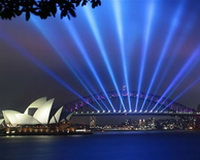Sydney Celebrates New Year with Massive Fireworks
New Year arrived first in the South Pacific. At midnight local time (1100 GMT) fireworks were set off over Auckland's Sky Tower in New Zealand.

A massive fireworks display has taken place in Sydney, Australia, with some 5,000kg of explosives sent up around around the famous harbour bridge.
An estimated 1.5 million attended the city's dramatic show.
Fireworks were launched from the bridge, from boats in the harbour and from buildings around the waterfront, BBC News reports.
It was also reported, the annual New Year's Eve fireworks display illuminates the sky over Sydney Harbour on December 31, 2009 in Sydney, Australia. The 2009 into 2010 theme is 'Awaken The Spirit' with over 1.5 million people expected to gather around the harbour to watch the12 minute show, KMOX.com reports.
In the meantime, millions of Japanese were to welcome the New Year by flocking to shrines to pray for good fortune in 2010.
In the Philippines, officials say about 230 people were hurt by firecrackers and celebratory gunfire despite a government scare campaign, warning people to take precautions and threatening violators of safety rules with arrest.
Many Filipinos, largely influenced by Chinese tradition, believe that noisy New Year's celebrations drive away evil and misfortune.
Fireworks displays were planned to illuminate Hong Kong's crowded skyline, glitzy parties were planned in Singapore, and thousands gathered at Indonesia's national monument in the capital, Jakarta, for a fireworks show.
China uses a different calendar that will mark the New Year in February. Nevertheless, President Hu Jintao wished viewers a happy new year in his end-of-the-year speech broadcast on China Central Television, CBC.ca reports.
Meanwhile, the New Year was celebrated by Romans who used Janus as a symbol of the occasion while seeking forgiveness from their enemies. It was also a time to exchange gifts with one another.
During the Middle Ages, Christians moved New Year's Day to December 25 -- hence the blurry division of New Year's celebrations and the Christmas holiday. The official New Year's Day was then moved to March 25 and called "Annunciation."
Pope Gregory XIII sorted everything out in the 16th century when he revised the Julian calendar and returned the New Year's celebration to January 1, ABC12.com reports.
Subscribe to Pravda.Ru Telegram channel, Facebook, RSS!





